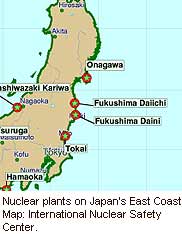
TUESDAY, March 15 (HealthDay News) — The crisis at Japan’s stricken complex of four nuclear reactors deteriorated dramatically Tuesday as explosions continued to rock the site and reports emerged that water in a pool used to cool spent fuel rods may be boiling.
More radiation was released from the complex that was devastated by Friday’s earthquake and resulting tsunami, and Prime Minister Naoto Kan said the radiation had leaked from the four reactors, the Associated Press reported.
“The level seems very high, and there is still a very high risk of more radiation coming out,” he said.
To combat health risks to residents, government officials were planning to distribute potassium iodide pills — to prevent thyroid cancer, the most immediate risk. However, in a worst-case scenario — large amounts of released radiation — the result could be many other types of cancers years later, the AP reported.
Radiation experts said the threat to North America was virtually non-existent because any escaped radiation would dissipate before it crossed the Pacific Ocean.
One radiation expert, Jacqueline Williams, a research professor in the department of radiation oncology at the University of Rochester in New York, said high levels of radiation — potentially like those experienced by workers at the nuclear complex — can be lethal because “radiation disrupts your cells and you die.”
The danger to people outside the immediate area could come from inhaling radioactive particles, Williams said. The type of radiation released into the air would depend on the type of fuel used at a plant, she added.
Often the big components of released radiation are radioactive iodine and radioactive cesium, Williams said.
Breathing in or eating food contaminated with radioactive iodine can cause thyroid cancer. Food can become contaminated as the radioactive dust settles on crops and even grass that cows or other animals eat, she explained.
Radioactive cesium can cause more damage long-term, including cancer and lung problems, Williams said.
Workers at the crippled plant continued Tuesday to desperately try to avoid a complete meltdown at the reactors — the melting of the radioactive core — that could release radioactive contaminants into the environment and pose major, widespread health risks, the AP reported.
According to The New York Times, workers — at great personal peril — continued to pump seawater into the reactors in an attempt to keep them cool. The last-ditch effort was needed because Friday’s twin disasters had knocked out conventional cooling systems and backup generators. Most of the 800 workers at the plant had been removed, with a skeleton crew of about 50 or so workers still on hand, while crews battled a fire at one of the reactors.
A “meltdown” isn’t a technical term, but instead a layman’s description of a serious collapse of a power plant’s systems and ability to control temperatures, the AP reported.
Still, even a meltdown would not necessarily mean catastrophe, experts said: it depends on the amount and type of radioactive materials. Donald Olander, professor emeritus of nuclear engineering at the University of California, Berkeley, said even the much higher levels of radiation reported on Tuesday are “not a health hazard,” the AP reported.
Experts put the situation in Japan in context to the two biggest nuclear reactor scares in the past — in 1986 at the Chernobyl plant in the Ukraine, and in 1979 at the Three Mile Island plant in Pennsylvania.
At Three Mile Island, even though a quarter of the reactor core melted, the steel containment structure held. The radiation released was so small that it did not threaten health, the AP said.
At Chernobyl, where there was no containment vessel like those in Japan or Three Mile Island, far more radioactive material was released, and it was a more dangerous type than at Three Mile Island. The radiation remained in soil and worked its way into vegetation in the Ukraine, contaminating milk and meat for decades. Thousands of children developed thyroid cancer from radiation exposure, the news service said.
“Right now it [the crisis in Japan] is worse than Three Mile Island,” said Olander. He believes that even the heavily elevated levels of radiation around the four reactors are “not a health hazard.” But without knowing specific dose levels, he said it was hard to make judgments, the AP said.
More than 200,000 people had been evacuated from the area around the Japanese reactors as a precaution.
How far radioactivity might spread would depend on weather conditions such as wind and rain, Williams said. These factors also need to be taken into account when deciding how far to move people from potential danger.
“The best protection from radiation is to get inside,” she said. “Get something between you and the radiation.”
Friday’s earthquake and tsunami that pounded Japan’s northeastern coast has left at least 2,800 people dead and hundreds missing, according to government officials. But police in one of the hardest-hit areas said the death toll there alone could eventually top 10,000, the AP reported.
More information
For more on the health risks of nuclear radiation, visit the University of Pittsburgh.

